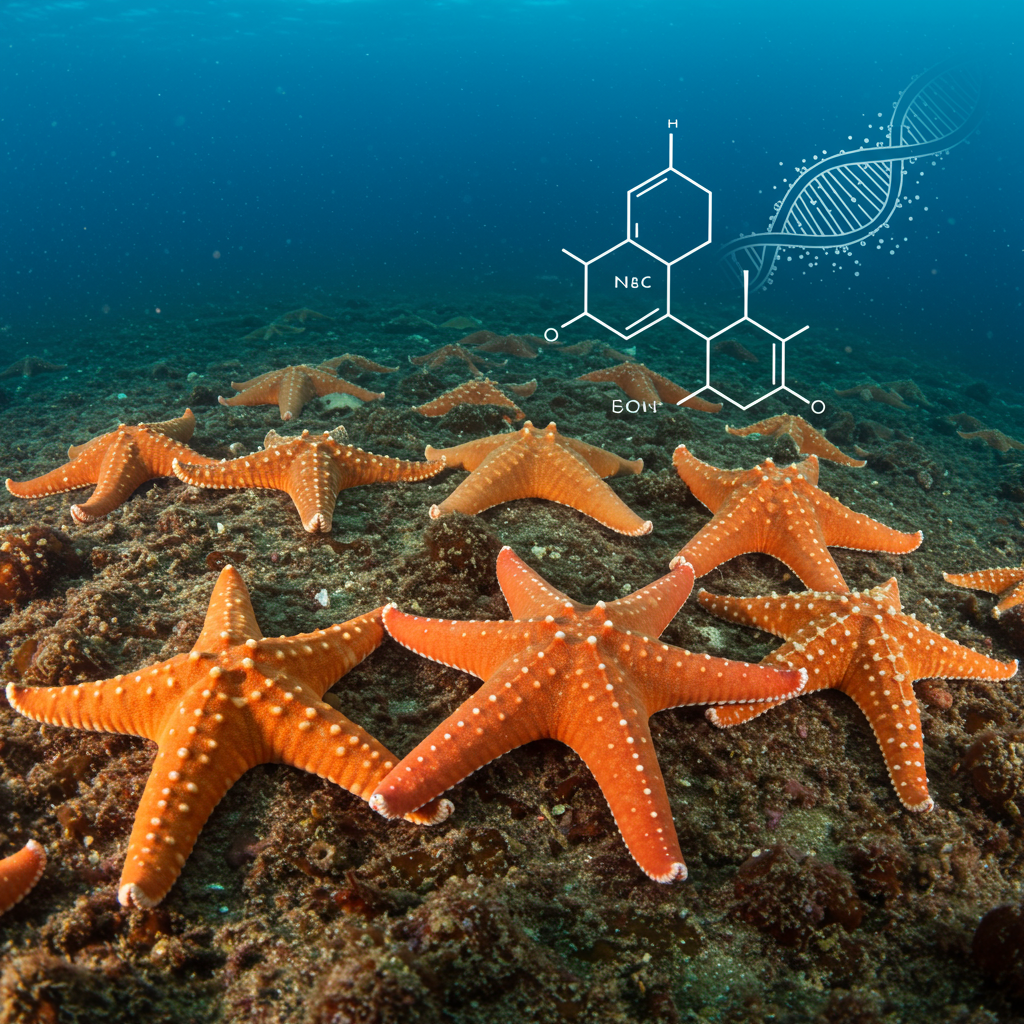For over a decade, a devastating and mysterious illness has ravaged sea star populations along North America’s Pacific Coast. This dire event, known as Sea Star Wasting Disease, turned vibrant ocean floors into barren landscapes, causing billions of these crucial marine animals to melt into gooey masses. Now, after years of intense scientific investigation, researchers have finally pinpointed the bacterial culprit: Vibrio pectenicida. This monumental discovery not only unravels one of the largest marine disease outbreaks on record but also ignites hope for the recovery of these iconic creatures and the vital marine ecosystems they support.
The Gruesome Reality of Sea Star Wasting Disease
First appearing in June 2013 near Washington State’s Olympic National Park, the sea star wasting disease quickly spread with alarming speed. The deadly enemy began its work from Alaska’s frigid waters to Mexico’s warmer coasts. Infected sea stars, often misidentified as ‘starfish’ despite being echinoderms, underwent a horrifying transformation. They became lethargic, developed tell-tale white lesions, experienced limb detachment, and tragically disintegrated into what scientists described as ‘mushy blobs’ or ‘gooey masses,’ often within mere days. Some succumbed in as rapidly as 24 hours. Marine disease ecologist Alyssa Gehman vividly labeled the condition as ‘gruesome,’ noting the distressing sight of their arms literally falling off.
This epidemic reached its peak between 2013 and 2017, leading to an unprecedented die-off. The majestic sunflower sea star (Pycnopodia helianthoides), a species capable of stretching over three feet tip-to-tip, bore the brunt of the devastation. Over 90% of its population vanished, making it one of the largest recorded marine wildlife disease outbreaks. While the sunflower sea star was the most susceptible, the pathogen affected more than 20 different sea star species, dramatically altering coastal biodiversity across vast regions. Once abundant, these multi-armed creatures became a rare sight, especially in Southern California, where their populations plummeted to near extinction. Overall, the disease is responsible for the demise of over 5 billion sea stars.
A Decade-Long Ecological Catastrophe
The widespread loss of sea stars, particularly the voracious sunflower sea star, triggered a cascade of negative effects throughout the marine ecosystem. As apex predators, these sea stars played a crucial role in controlling populations of sea urchins. With their primary predator gone, sea urchin numbers exploded unchecked. This unchecked growth had dire consequences for the vital kelp forests along the Pacific coast.
Often referred to as the ‘rainforests of the ocean,’ kelp forests provide essential habitat, food, and shelter for an immense diversity of marine life. This includes countless fish species, sea otters, and seals. The explosion of sea urchins led to the severe degradation and collapse of these underwater ecosystems. In parts of Northern California, an astonishing 95% of kelp forests were wiped out within a decade. This demonstrated the profound ripple effect of losing a single keystone species. This ecological imbalance not only disrupted delicate food webs but also impacted commercial fisheries dependent on healthy coastal habitats.
The Scientific Detective Work: Unraveling the Mystery
Solving the riddle of sea star wasting disease was a monumental scientific undertaking that spanned years. It involved a vast international collaboration. A team of at least 15 scientists from diverse organizations joined forces. These included the Hakai Institute, University of British Columbia, The Nature Conservancy, Tula Foundation, University of Washington, and U.S. Geological Survey. Their four-year investigation began with collecting wild sunflower sea stars from various locations between 2021 and 2024. This was followed by meticulously controlled experiments and rigorous DNA analyses.
Early in the investigation, researchers pursued several leads, including a suspected densovirus. However, further studies revealed this particular virus was a normal resident in healthy sea stars. It was not the cause of the disease. The true breakthrough came from a critical shift in focus: analyzing the coelomic fluid, essentially the ‘blood’ surrounding sea star organs, rather than just deceased tissue samples. Co-author Melanie Prentice experienced an ‘aha’ moment while scrutinizing microbial data from sick sea stars. She noticed an overwhelming presence of Vibrio pathogens – a finding absent in healthy specimens.
In a pivotal meeting, she shared her discovery with colleagues Alyssa Gehman and Grace Crandall. They immediately began breaking down the genetic sequences. The culprit was unequivocally identified as Vibrio pectenicida. This clear, consistent pattern was strikingly apparent. “It was apparent immediately that it was in all of our wasting samples and none of our healthy samples,” Prentice stated. The team then dedicated another year to meticulously validating their conclusions. They consistently found more evidence that Vibrio pectenicida was indeed the pathogen causing the devastating sea star wasting disease. Experts like marine disease ecologist Kevin Lafferty lauded the work. He emphasized the immense difficulty of diagnosing marine diseases and the groundbreaking use of modern molecular tools. These tools can now identify numerous bacterial species from a simple water sample.
Understanding Vibrio pectenicida and Its Role
Vibrio pectenicida belongs to the Vibrio genus, a large and common group of bacteria found in marine environments. Many Vibrio species are known pathogens. Some cause diseases in shellfish, and others, like the one responsible for cholera, are highly dangerous to humans. While Vibrio pectenicida was previously known to infect shellfish, its role in the widespread sea star wasting disease was a surprising revelation for the research team.
The simplicity of the discovery — that a single, identifiable bacterium was the primary driver — surprised scientists. They had anticipated a far more complex answer. Although some experts, like marine ecologist Ian Hewson, initially expressed reservations due to past studies where Vibrio pectenicida wasn’t consistently found, the current research offers a strong explanation. Previous investigations often examined a ‘hodgepodge of sea star tissues.’ In contrast, this study meticulously focused on isolated coelomic fluid. Here, the stark contrast in microbial profiles between healthy and sick sea stars was undeniable. Moreover, a crucial direct inoculation experiment provided compelling evidence: healthy sea stars injected with cultured Vibrio pectenicida succumbed to the disease within days, firmly establishing a causal link.
Paving the Way for Recovery and Resilience
The definitive identification of Vibrio pectenicida as the cause of sea star wasting disease marks a pivotal turning point for conservation efforts. This discovery “opens up a door that wasn’t available to us,” according to Alyssa Gehman. Researchers are now rapidly developing practical intervention strategies aimed at helping sea star populations recover and thrive once more.
One immediate and crucial development is the creation of rapid diagnostic tests, akin to those used for COVID-19. These tests will allow researchers to quickly detect Vibrio pectenicida in both sea stars and their surrounding water. This will prove invaluable for managing remaining healthy populations and informing potential reintroduction efforts. Scientists are also exploring several promising avenues for population recovery. These include establishing captive breeding programs using the remnant healthy sunflower sea star populations found in Alaska, British Columbia, and parts of Washington. The goal is to raise animals that might possess natural resistance to the pathogen.
Further possibilities include investigating probiotic treatments, similar to those successfully used to enhance immunity in some corals. Another cutting-edge approach involves leveraging naturally occurring marine viruses, known as phages. These specifically target and destroy harmful bacteria – a technique already aiding abalone population recovery. Despite these breakthroughs, important questions remain, such as the exact origin of the pathogen and whether warmer ocean temperatures exacerbate its proliferation. Future research will likely explore potential transmission routes, including from mollusks (a common food source) or through aquaculture practices. The ultimate hope is that these comprehensive efforts will one day allow scientists to successfully reintroduce thriving sea stars back into their former habitats, restoring balance to the Pacific’s vital marine ecosystems.
Frequently Asked Questions
What is Sea Star Wasting Disease and how does it affect sea stars?
Sea Star Wasting Disease is a devastating illness that causes sea stars to become lethargic, develop white lesions, lose their arms, and rapidly disintegrate into gooey masses, often within days. This gruesome condition is caused by the bacterium Vibrio pectenicida. The disease first emerged in 2013 and has since wiped out billions of sea stars along the Pacific Coast of North America, particularly impacting the sunflower sea star population, which saw over 90% decline. It also severely disrupts marine food webs.
Why is the decline of sea stars, especially the sunflower sea star, so impactful on marine ecosystems?
The dramatic decline of sea stars, particularly the sunflower sea star, has profound ecological consequences because they are keystone predators. They play a critical role in controlling populations of sea urchins, which are voracious grazers of kelp forests. With fewer sea stars to keep them in check, sea urchin populations have exploded, leading to the severe degradation of kelp forests—vital habitats often called the ‘rainforests of the ocean.’ This ecological imbalance affects countless other marine species that rely on kelp for food and shelter, disrupting entire marine ecosystems and even commercial fisheries.
What conservation efforts are underway to help sea star populations recover?
Scientists are actively working on several fronts to help sea stars recover following the identification of Vibrio pectenicida. Key initiatives include developing rapid diagnostic tests to monitor the pathogen in water and sea stars, enabling timely interventions. Researchers are also establishing captive breeding programs using healthy remnant populations, aiming to cultivate disease-resistant animals. Future possibilities involve exploring probiotic treatments to boost immunity and using specific marine viruses (phages) to target the harmful bacteria. The ultimate goal is to reintroduce thriving sea stars back into their natural habitats, restoring the balance of the affected marine ecosystems.
Conclusion
The identification of Vibrio pectenicida marks a monumental breakthrough in understanding and combating Sea Star Wasting Disease. This decade-long mystery, which brought the once-abundant sunflower sea star to the brink of extinction and severely damaged kelp forests, now has a scientific answer. Armed with this crucial knowledge, marine biologists and conservationists can finally develop targeted strategies for recovery. The path forward involves innovative diagnostic tools, strategic breeding programs, and potential treatments that promise a brighter future for these vital echinoderms. As we work to heal our oceans, restoring sea star populations is not just about saving a single species, but about revitalizing entire marine ecosystems and ensuring the health of our planet’s underwater ‘rainforests’ for generations to come.




